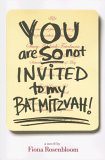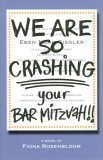new posts in all blogs
Viewing: Blog Posts Tagged with: Race, Most Recent at Top [Help]
Results 1 - 8 of 8
How to use this Page
You are viewing the most recent posts tagged with the words: Race in the JacketFlap blog reader. What is a tag? Think of a tag as a keyword or category label. Tags can both help you find posts on JacketFlap.com as well as provide an easy way for you to "remember" and classify posts for later recall. Try adding a tag yourself by clicking "Add a tag" below a post's header. Scroll down through the list of Recent Posts in the left column and click on a post title that sounds interesting. You can view all posts from a specific blog by clicking the Blog name in the right column, or you can click a 'More Posts from this Blog' link in any individual post.

By:
Justine Larbalestier,
on 2/20/2008
Blog:
Justine Larbalestier
(
Login to Add to MyJacketFlap)
JacketFlap tags:
DNA testing,
Writing & Publishing,
Next novel,
DNA testing,
race,
Research,
race,
Writing & Publishing,
Next novel,
Add a tag
Than you so much for all the excellent liar info yesterday. I’m now halfway through Paul Ekman’s Emotions Revealed: Recognising Faces and Feelings to Improve Communication and Emotional Life and finding it extraordinarily useful. Thanks to Gwenda Bond, Jenny Davidson and Malcolm Tredinnick for suggesting him. I’ll be chasing down all the other leads as well. You are all the best research assistants ever!
Since you were all so amazingly helpful on yesterday’s research question I have another:
Last year (I think) I read at least two articles about DNA testing being used in a classroom (or possibly classrooms) in California (but I may have the state wrong) to demonstrate that no one is racially “pure” and, indeed, to promote discussion about what race even is. The test gives the percentage of your DNA that comes from Africa, Europe, Asia or Native America. And many people get results they’re not expecting. The correlation between your skin colour and your DNA is not straightforward.
I have googled any number of combinations and have found articles on DNA testing and race. Even on DNA testing being taught in the classroom, but not on DNA tests being used to talk about race in the classroom.
If any of you can help with this I will be eternally grateful.
 I was tagged by Varenia Jensen recently for 7 things about me. I was reading Becky's new blog today and decided to post my own rubber ducky. And then it occurred to me I could tell you about it along with telling you some things about me.
I was tagged by Varenia Jensen recently for 7 things about me. I was reading Becky's new blog today and decided to post my own rubber ducky. And then it occurred to me I could tell you about it along with telling you some things about me.
1. First of all this ducky came in a tiny kit that was given to a friend's grandma on the airplane when visiting from England. I think it also came with a tiny toothpaste and other things like that. This grandma was not interested in the kit, possibly because poor eyesight precluded much enjoyment of such tiny things. So the friend received the kit and then gave it to me because I love kits. And tiny things. Preferably things with a purpose, not just knick-knacks. Not that this duck has a purpose but I've always wanted one and never had much room so having the smallest one ever was kind of convenient.
2. Speaking of not having much room, there's a reason for all the organization you're seeing on my blog. I've always lived in a pretty small space. Before this house, my husband and I shared a 400-square-foot condo. And we did quite well, but everyone thought we were crazy and now that we're ensconsed in a palatial 600-square-foot house I quite agree.
3. Anyway back when we were living in the condo a certain small visitor of ours, perhaps at the age of 3, discovered this rubber ducky on a visit to the bathroom. Played with it for a bit then pocketed it and took it home. I didn't notice until I got a call from her dad who mentioned that she had the ducky and would be returning it. Now there a couple things about me here that I could tell you.
4. First of all, I did things like that All The Time when I was little. Just weird little errors in judgment. Such as the time I cut off all my eyelashes (because I thought the eyelash stubble would feel interesting - which it did) and was barred from using scissors for ages. Which was a real punishment for someone who loved cut and paste as much as I did.
5. Second of all, I was quite sympathetic and thought she should just keep the ducky and she was welcome to it. But I knew that wasn't allowed because she had to learn the Lesson. Don't Go To Someone's House, Find Something You Like, Pick it Up and Take it Home. Anyway now that it's been returned and a couple of years have gone by maybe I can give it back to her now. Which is what I wanted to do it the first place and shows you I'd be hopeless at teaching such lessons.
6. Which brings me to another thing about me. I still have the thing. I'm not really attached to it anymore but I wouldn't just throw it out. In general I do get attached to things and can't let them go. But I'm getting better and lately I've been giving all kinds of things away. I think it's part of being Anthea Turnered, or generally influenced by all those tidying & decorating shows. And it does feel really good, because you appreciate the things you have, the space and being able to find things.
 7. And finally in case you think my place is looking really incredibly organized and nice, believe me, those are the pictures I'm showing you, and there are still plenty of things still lying around waiting to be sorted out. And the house still needs tons of work that we can't really afford to do right now - for example you can see in the picture above, a giant (1970s?) washing machine that we have crammed into our bathroom. There's really nowhere else to put it and it's such an eyesore.
7. And finally in case you think my place is looking really incredibly organized and nice, believe me, those are the pictures I'm showing you, and there are still plenty of things still lying around waiting to be sorted out. And the house still needs tons of work that we can't really afford to do right now - for example you can see in the picture above, a giant (1970s?) washing machine that we have crammed into our bathroom. There's really nowhere else to put it and it's such an eyesore.
So here's who I'm tagging:
1. the sweetie pie press
2. toronto craft alert
3. seams likely
4. hazeljoy
5. hey lucy
6. bamboo sticks
7. hurrayic
Here's the rules:
1. Link to your tagger and post these rules on your blog.
2. Share 7 facts about yourself on your blog, some random, some weird.
3. Tag 7 people at the end of your post by leaving their names as well as links to their blogs.
4. Let them know they are tagged by leaving a comment on their blog.
Imitation of Life by Fanny Hurst was published to great success in 1933, made into a film in 1934, and then again in 1959. All three are a fascinating window on race in the USA. Fascinating and deeply depressing.
The movies are kind of an obsession of mine. Particularly the contrast between them. So much changed in those intervening 25 years, and so very little. David Kehr in today’s New York Times describes the films thus:
Douglas Sirk’s 1959 “Imitation of Life” is among the most closely analyzed films in the Hollywood canon, a Lana Turner soap opera  turned into an exercise in metaphysical formalism by Sirk’s finely textured and densely layered images. Less well known is John M. Stahl’s first film version (1934) of this Fannie Hurst novel about the complex bond between an enterprising white businesswoman (Claudette Colbert) and the black woman (Louise Beavers) who becomes her housekeeper and supplies the secret formula for pancakes that becomes the basis of Colbert’s character’s empire.
turned into an exercise in metaphysical formalism by Sirk’s finely textured and densely layered images. Less well known is John M. Stahl’s first film version (1934) of this Fannie Hurst novel about the complex bond between an enterprising white businesswoman (Claudette Colbert) and the black woman (Louise Beavers) who becomes her housekeeper and supplies the secret formula for pancakes that becomes the basis of Colbert’s character’s empire.
That was the year that Hollywood began seriously to enforce what had been the largely toothless Production Code, which, among its many nefarious effects, would result in the near disappearance of socially engaged films for the next two decades. But Stahl’s “Imitation of Life” still benefits from the frankness and skepticism of the early Depression years. Though hardly free from stereotyping, it stands today as perhaps the most powerful Hollywood film about race until the civil rights movement of the 1950s.
Hardly free from stereotyping is right. The black characters are happy with their place in the world. All but the housekeeper’s daughter, Peola, who is so light-skinned she can pass for white. Yet in both films her decision to do so seems inexplicable. The black people are all happy. Why would you want to be pretend to be one of the tormented white people? Look how hard the white man’s burden is!
If you were an alien watching the movies you’d be scratching your head trying to figure out what was so very terrible about being black. In neither film are there any cafes with signs saying “Whites Only.” The black characters never have to sit at the back of the bus. There’s no mention of slavery, lynchings, or the civil rights movement.
There is one horrible scene of racism in the 1959 version, but it plays out as though racism is just that particular person’s problem, not anything systemic. The most you get in the 1935 version is the kids at school looking shocked when they discover that Peola is passing. Their reaction shot lasts less than five seconds.
One of the things that puzzles me most is that in 1934 a black actress was cast in the role of the daughter who passes as white, but in 1959 she was played by a white actress. What’s up with that? Were there truly not any light-skinned actresses of Fredi Washington’s (pictured above) calibre around in the 1950s? Colour me doubtful.1
I find the 1934 version more powerful because it doesn’t lose its focus on racism; the 1959 movie winds up being largely about Lana Turner’s scandal ridden life, specifically her daughter killing her mobster boyfriend. David Kehr’s is spot on about the final scene of both movies:
Like the Douglas Sirk version, Stahl”s “Imitation of Life” climaxes with a lavish funeral procession. But what Sirk turns into a triumph of coolly expressive visual style becomes, in Stahl”s version, a sustained march of silent protest against a system as unjust as it is deeply ingrained. The film seems unable to put a name to the monumental grief it depicts with such devastating force.
That’s a large part of the problem with boths films: they are about systemic racism and injustice, but they cannot name them. Both films are exercises in avoidance, shame, and lame liberal justifications. What fascinates me is their inability to articulate the bleeding obvious: It is unjust that the black woman who makes the white woman’s life of money and privilege gets so little for it. It is unjust that the black woman’s daughter cannot get what she wants unless she pretends to be white and then when she does that she is punished.
Both films are clear that the problem lies with Peola for trying to be something she is not. Her passing is what is at fault, not the system of racial inequality that makes passing as white an attractive path.
But most of all neither of these films are about Peola or her mother: They’re about the white woman. Claudette Colbert in the first film and Lana Turner in the second. I’ve always longed for it to be remade with the focus squarely on the black woman with the miracle pancake mix.2
Happy Super Tuesday to all you USians living in those states. Vote well! I bet Peola would be happy to see a black man in the running, but sad to see how much racial and sexual inequality still exists. But we can change that, right?

By: Jennie,
on 12/26/2007
Blog:
Biblio File
(
Login to Add to MyJacketFlap)
JacketFlap tags:
Juvenile,
coming of age,
Bat Mitzvah,
Gennifer Choldenko,
Bat Mitzvah,
Gennifer Choldenko,
Fiona Rosenbloom,
Bar Mitzvah,
Junior High,
Race,
YA,
Fiction,
Race,
Fiona Rosenbloom,
Bar Mitzvah,
Junior High,
Add a tag
I hope everyone's holidays are going/went well. I hope that Hanukkah Harry, Solstice Sam, Santa, and Kwanzaa Kofi were good to you and yours and that now you're all full of cookies and goodness and curled up with the parts of your family that don't drive you crazy and a good book.
I had to leave Wisconsin much too soon, but it was a lovely time even if the Packers totally sucked in Sunday's game. (ouch. seriously. ouch.) It even snowed...
Also, I got a lot of reading done. I now have 21 books to read before Monday turns to Tuesday. I can totally pull that off, right? Yeah, I know. But, it will be fun to see how far I get.
Anyway, here are a few of the books I read in various airport lounges, airplanes, and my parents' living room.
If a Tree Falls at Lunch Period by Gennifer Choldenko
Someone remind me to stay away from really well done non-humorous realistic fiction about junior high. They make all the memories I've worked so hard to repress come up.
Anyway, Kirstin's best friend is hanging around the mean girls they used to hate. Kirsten could maybe be included if she just tried a little harder to fit in. That's what her mom wants--to the point where she'll call up the other mothers. Kirsten's not dumb. She knows that Ms. Queen Bee doesn't want her there. She also knows she doesn't want to be there, so she starts hanging out with some other people.
Boys. Scholarship students.
Walk is one of those scholarship students-- one of a very few non-white students at this exclusive private school. He wishes he were back at his old school, with his friends...
Choldenko could have had a beautiful story, just on that. But there's also a deep dark looming secret. I'm not sure how I feel about that. It wasn't really necessary.
I did, however, love Kirsten's little sister, Kippy.
Thanks to
Kelly for turning me onto this title!
You Are SO Not Invited to My Bat Mitzvah! Fiona Rosenbloom
This was the very last book I read in 2006. I remember racing to the end so it would be done before we went out for New Years Eve so it would firmly end up in th 2006 pile.
Anyway, it's Bar and Bat Mitzvah season in Westchester County. So, 13 year olds dealing with the opposite gender, social ranking, friendships, divorced parents and geeky little brothers.
It's true to life while still being funny enough that it doesn't send me back into therapy.
It's a very nice coming-of-age (literally!) story.
My one complaint is that the time line is really screwed up. There are a few things that happen where the times of various events are mentioned, but it doesn't make any sense when you try to reconstruct the day. Plus, geeky little bro undergoes big changes over the book. But the book only takes place over the time span of 1 week, so that also doesn't make sense.
But this old review leads us to a new review!
We Are SO Crashing Your Bar Mitzvah! Fiona Rosenbloom
In this sequel (which I just read) Stacy and Lydia have a whole new look and can't wait to show Kelly.
Only Kelly's full time hanging out with the Chicas (mean girls!) and Stacy and Lydia aren't invited.
Literally. Queen Bee Kym's cousin Eben is having the Bar Mitzvah to end all Bar Mitzvahs and everyone else is invited.
So, Stacy and Lydia do the only sensible thing-- crash. Coupled with the outlandish lies they've been telling to make themselves seem cooler, they've spun a web that's about to catch them.
I think I liked it even better than the first one!

By: Rebecca,
on 8/30/2007
Blog:
OUPblog
(
Login to Add to MyJacketFlap)
JacketFlap tags:
duke,
A-Featured,
book,
Literature,
classics,
oxford,
American History,
Prose,
black,
A-Editor's Picks,
adventures,
club,
world s,
race,
arab,
finn,
huckleberry,
jim,
mark,
twain,
Add a tag

In chapter 24 of Adventures of Huckleberry Finn, Jim complains to the duke that “it got mighty heavy and tiresome to him when he had to lay all day in the wigwam tied with the rope” (143) pretending to be a runaway slave. So the duke comes up with a clever solution, “He dressed Jim up in King Lear’s outfit…and then he took his theatre-paint and painted Jim’s face and hands and ears and neck all over a dead dull solid blue, like a man that’s been drownded[sic] nine days…Then the duke took and wrote a sign on a shingle…Sick Arab-but harmless when not out of his head.”
Wait, it gets worse. (more…)
Share This

By: Rebecca,
on 7/24/2007
Blog:
OUPblog
(
Login to Add to MyJacketFlap)
JacketFlap tags:
history,
Law,
Education,
Politics,
oxford,
American History,
Board,
american,
A-Featured,
African American Studies,
rights,
race,
of,
Brown,
civil,
V,
Michael,
J,
Klarman,
backlash,
bancroft,
african,
Add a tag
Michael J. Klarman, won the Bancroft Prize in 2005 for From Jim Crow to Civil Rights: The Supreme Court and the Struggle for Racial Equality. Brown v. Board of Education and the Civil Rights Movement, is an abridged, paperback edition of his original masterpiece, which focuses around one major case, Brown v. Board of Education. In the original essay below Klarman, who is the James Monroe Professor of Law and Professor of History at the University of Virginia, explores political backlash.
While we ordinarily think of Brown v. Board of Education (1954) as contributing to the creation of the modern civil rights movement, Brown’s more immediate effect was to crystallize the resistance of southern whites to progressive racial change, radicalize southern  politics, and create a climate ripe for violence. Indeed, prominent Court decisions interpreting the U.S. Constitution have often produced political backlashes that undermine the causes that the rulings seem to promote. (more…)
politics, and create a climate ripe for violence. Indeed, prominent Court decisions interpreting the U.S. Constitution have often produced political backlashes that undermine the causes that the rulings seem to promote. (more…)
Share This
 Heaven races are fantastic!
Heaven races are fantastic!
I have never gone to WisCon, and so I am always grateful afterwards for the many detailed reports on discussions from the convention, and the extensions of those discussions. The one I've been enjoying (and sometimes cringing) reading recently grows out of last year's panel and follow-up discussions of cultural appropriation. There are already a bunch of blog posts involved, but here are the paths in that I've been following:
Separate from the discussions of cultural appropriation (but valuable to look at alongside them), I discovered Robert Philen's post on
"Talking About Race" via
Reginald Shepherd, who also recently wrote a long and thoughtful post titled
"Some Thoughts on Race and Academia".





 turned into an exercise in metaphysical formalism by Sirk’s finely textured and densely layered images. Less well known is John M. Stahl’s first film version (1934) of this Fannie Hurst novel about the complex bond between an enterprising white businesswoman (Claudette Colbert) and the black woman (Louise Beavers) who becomes her housekeeper and supplies the secret formula for pancakes that becomes the basis of Colbert’s character’s empire.
turned into an exercise in metaphysical formalism by Sirk’s finely textured and densely layered images. Less well known is John M. Stahl’s first film version (1934) of this Fannie Hurst novel about the complex bond between an enterprising white businesswoman (Claudette Colbert) and the black woman (Louise Beavers) who becomes her housekeeper and supplies the secret formula for pancakes that becomes the basis of Colbert’s character’s empire.





Was it the “DNA Test Gives Students Ethnic Shocks” article on this page?
Oh, I have to go first again?!
I think the articles you might be remembering were tests conducted a couple of years in a row at Penn State University (as part of a Racial Relations class). At least, that was my memory of them and a quick Google around shows up a few dozen popular press articles on this, although I didn’t look long enough to find anything academic.
Megan & Malcolm: I’m pretty sure the Penn State test is not what I’m remembering. The one thing I’m positive about is that it was a high school classroom, not a university.
you are doing very interesting research. you’ve got me curious!
i don’t know anything about this dna testing and race stuff, but i’d love to hear more.
this is totally random, but because you’re the (first) one who got me interested in this book…i got a copy of skin hunger today!!! i’m in the middle of another book, and then there will be the two sequels to read after that…but i’ll be reading it soon. i can’t wait!!
Dragonfly: Is serkrit. Top sekrit. But you’ll be able to read it September 2009. Unless I change my mind . . .
Enjoy Skin Hunger!
justine: i see you learned how to spell from mj. or did she learn from you??
september 2009. for my birthday! (oh my socks, i’ll be over 30.)
That spelling of secret pre-dates either one of us using it. I’m even pretty sure that spelling pre-dates LOLcats.
But, it is very likely she stole it from me. Since she has a tendency to do that. A lot.
Hmmm . . . I’m in California and haven’t heard about it in classrooms. However, l gave my husband a DNA test for his birthday last year. I got it from National Geographic online. They’re amassing a huge data base.
Like most, my white husband roots are in Africa.
What were his percentages?
Where on earth do you go to get your DNA tested?
(This preview-as-you-type feature is the best stuff on earth. :-D)
Camille, here’s where I got my husband’s DNA kit . . .
https://www3.nationalgeographic.com/genographic/
It’s a really easy test to take. And then you mail it in and they send you the results.
Justine, I’ll ask him where he’s put the results and try to find out the percents.
I wanted one of those DNA testing things for my 16th B-Day, but my parents thought it was too expensive.
I go to school in California, and I haven’t heard about that either, albeit, my school is quite crappy and poor.
In my race and racism class in college we watched a film that showed high school students doing an experiment like that. Basically they discovered that a kid from Mexico’s closest genetic match was from Poland (arbitrary examples though). I don’t remember what the film was called, but it looked relatively old.
And I want to say that it sounds like something David Suzuki would have covered on The Nature of Things, but I might be wrong about that.
Hi Justine,
Check out the resources for teachers on the companion website to the PBS doc, African American Lives 2 http://www.pbs.org/wnet/aalives/teachers/rationalizing_race.html
It also links to another PBS companion website, Race: The Power of Illusion.
http://www.pbs.org/race/002_SortingPeople/002_00-home.htm
Hope this is helpful. Ariel
hey justine, i hadn’t heard about this either, but the ladeez at racialicious would know if anyone would.
http://www.racialicious.com/
well, in my science class the teacher paid for three randomly selected kids to have their DNA tested and anylyzed (the test kits are not cheap) but we’re using the data to learn about DNA not race.
~Moose-la
Hey, Justine, pretty sure this isn’t what you remembered, because it’s recent, but here is a link to an article about a project at a St. Louis school:
http://www.news-leader.com/apps/pbcs.dll/article?AID=/20080217/NEWS01/802170397
“As the results of the school’s “Discover Your Roots” project began to trickle in earlier this month, the 40 students and teachers participating in the human genome program began comparing notes the moment the school’s computers spit out the results of their DNA tests.”
Hope that helps, even if it wasn’t what you were looking for…
emily
Justine, sadly my Hubby can’t find his DNA test information. However, I can recall that he’s part European, part African, and part martian.
i’m not good at linking to stuff, but i went to google and put DNA+Race…and a bunch of stuff came up.